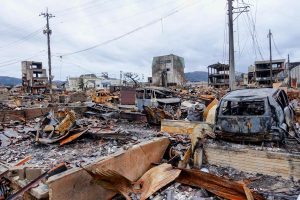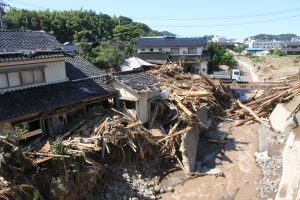News
2025.05.30
Columns
Wajima Lacquerware: The Inherited Artistry Sustained by a Division of Labor
Table of Contents
1. Introduction
2. Characteristics of Wajima-nuri and Three Techniques
3. History of Wajima-nuri
4. Inheritance of Tradition and Challenges
5. Conclusion
Introduction
A Wajima-nuri globe, “Earth at Night,” is exhibited at the Expo 2025 Osaka Kanasai. This work, which is 1 meter in diameter and weighs 215 kilograms, depicts the night view of the Earth as seen from space, and is characterized by the fantastic beauty of the gold coloring on the jet-black globe.
Wajima-nuri (Wajima Lacquerware) is a lacquerware produced in Wajima City, Ishikawa Prefecture, and is attractive for its robustness, lustrous texture, and gorgeous design. A variety of products that blend into everyday life, such as bowls, trays, and stacked boxes, have been produced. The manufacturing process involves more than 120 steps, and is made up of eight different types of work by skilled craftsmen.
However, Wajima City suffered severe damage from the 2024 Noto Peninsula earthquake and the Oku-Noto heavy rains. The Wajima-nuri globe was completed in March 2022 and was on display at the Wajima Museum of Urushi Art in Ishikawa Prefecture at the time of the disaster, but it miraculously remained intact and is positioned as “one of the symbols of reconstruction.”
In this column, we will introduce the characteristics, history, and current challenges of Wajima-nuri.
Characteristics of Wajima-nuri and Three Techniques
Wajima-nuri is made using natural wood and lacquer, and is made using a complete division of labor system. It is characterized by its outstanding robustness and gorgeous finish, achieved using three techniques: Jinoko, Nunogise, and Chinkin.
Jinoko
General lacquerware is finished by applying lacquer directly to the wood base, but Wajima-nuri uses soil called “Jinoko” as a base. “Jinoko” is a type of diatomaceous earth found on Mt. Komine in Wajima City. By mixing it with lacquer and applying multiple layers, lacquerware that is extremely resistant to impact and wear is completed.
Nunogise
This is a technique of attaching cloth to the rim and bottom of a bowl using “Kisemono Urushi” (made from raw lacquer and rice paste). This not only prevents cracks and chips, but also prevents moisture from penetrating the wood. By strongly adhering the cloth to the wood, the finish is more durable.
Chinkin
Chinkin is one of the decorative techniques established in Wajima. Delicate patterns are engraved into the lacquer surface with a carving knife, and lacquer is rubbed into the grooves and gold or silver powder is embedded to create gorgeous patterns. This technique allows for beautiful decoration with a three-dimensional effect.
History of Wajima-nuri
◇Origin
Lacquerware has been made on the Noto Peninsula since ancient times, and its history dates back to the Jomon period. Lacquerware products have been found in ruins from the Heian period in Wajima City. The origin of Wajima-nuri is unclear, but bowls made from jinoko have been excavated from ruins from the Muromachi period. In addition, in 1524, the vermilion-lacquered door of Juzo Shrine, which is said to be the oldest surviving Wajima-nuri, was made. From these, it is believed that the technology that became the prototype of modern Wajima-nuri was born during the Muromachi period.
◇Development in the Edo Period
In the early Edo period, the traditional technique of Wajima-nuri, which mixes ground powder with lacquer, was established. With this technique, Wajima-nuri established a reputation as a sturdy lacquerware and spread throughout the country.
◇Meiji Period and After
In the Meiji period, Wajima-nuri developed further and began to be exhibited at domestic and international expositions. In 1975, it was designated as a traditional craft by the Ministry of International Trade and Industry at the time, and in 1977, it was the first lacquerware in the country to be designated as an Important Intangible Cultural Property. Even today, Wajima-nuri preserves its traditions, but also features designs that are easy to use in everyday life and modern pieces, making it popular with a wide range of generations.
Inheritance of Tradition and Challenges
The current challenges for Wajima-nuri are recovery from the earthquake disaster and the aging of craftsmen. In the Noto Peninsula earthquake that occurred in January 2024, 13 of the 103 companies affiliated with the Wajima-nuri Commerce and Industry Cooperative were lost, 50 were completely or partially destroyed, and almost all of the other workshops were damaged. Since many of the craftsmen worked in an environment where their homes and workshops were integrated, they had to start by rebuilding their daily lives.
Furthermore, the Oku-Noto heavy rains occurred in September of the same year, and the residents of Wajima City are facing a difficult situation. In addition, the problem of a lack of successors due to the aging of craftsmen is also serious, and many craftsmen have decided to close their businesses in response to the disaster. Because Wajima-nuri is made through a division of labor system, if even one craftsman is missing, production becomes difficult and the industry is in danger of disappearing.
In response to this, Ishikawa Prefecture has announced its intention to establish a new facility for training young talent by fiscal year 2027. As Wajima-nuri businesses are no longer able to train young craftsmen, the public and private sectors and the production area are working together to attract young people and promote Wajima-nuri both domestically and internationally.
▼Damage caused by the Noto Peninsula earthquake (photo by Ishikawa Prefecture website)

▼Damage caused by heavy rains in Oku-Noto (photo by Ishikawa Prefecture website)

Conclusion
Wajima-nuri is one of Japan’s most representative traditional crafts, supported by a long history and outstanding techniques. Its beauty and practicality have been protected and passed down through the passion and efforts of craftsmen. However, due to recent earthquakes and the aging of craftsmen, its survival is in doubt.
The Wajima-nuri globe “Earth at Night” on display at the Expo 2025 Osaka Kansai is truly a symbol of connecting tradition and the future. By sharing this work with the world, we hope that the value of Wajima-nuri will be widely recognized and that efforts to train successors and revive the craft will accelerate.
We hope that historic Wajima-nuri will continue to reach many people and continue to shine in their daily lives.
(Reference)
Wajima-nuri Large Globe “Earth at Night” to be Exhibited | Expo 2025 Osaka, Kansai, Japan Official Website
Traditional Industries | Ishikawa Prefecture
Photos of the damage | Ishikawa Prefecture
Category
Archive

